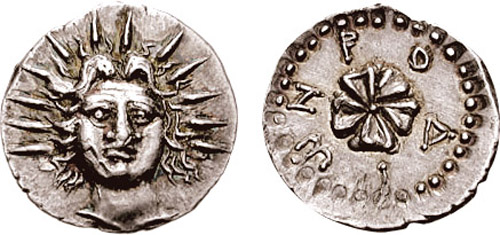Rhodes, silver, drachms (facing Helios/rose) (30 BCE-100 CE)
From SILVER
30 BCE - 100 CE Silver 334 kg
Description
| ObverseInscription or printing placed on the obverse.: | Radiate facing head of Helios |
| ReverseInscription or printing placed on the reverse.: | ΡΟΔΙΩΝ (Greek).Open rose seen from above |
Mint and issuing power
| MintIdentifies the place of manufacture or issue of a numismatic object.: | Rhodes | Ancient regionAncient region.: | Caria (islands) | Modern countryModern country: Greece | AuthorityIdentifies the issuing power. The authority can be "pretended" when the name or the portrait of X is on the coin but he/she was not the issuing power. It can also be "uncertain" when there is no mention of X on the coin but he/she was the issuing power according to the historical sources: | Roman Empire |
Chronology
| FromIdentifies the initial date in a range assigned in a numismatic context. | 30 BCE | toIdentifies the final date in a range assigned in a numismatic context.. | 100 CE | PeriodTime period of the numismatic object.: Roman from 30 BC |
Physical description
| MetalThe physical material (usually metal) from which an object is made.: | Silver |
Median weightMedian of the weights of numismatic objects (in grams). in grams | 2.90 | DenominationTerm indicating the value of a numismatic object. Examples: tetradrachm, chalkous, denarius.: | drachma |
StandardStandard.: | Cistophoric |
Image

S983 Rhodes 30 BCE.jpg [1]
References
| Die study referencePublication of the study: | Ashton - Weiss 19971Ashton - Weiss 1997, p. 37-39 | ||
| Coin series referenceReference to coin series study: | RPC I2RPC I, n° 2744 | ||
| Coin series web referenceCoin series web references: | |||
Obverse dies distribution
| FrequencyFrequency of specimen in distribution. ᵖ | Number of obversesNumber of obverse dies. ᵖ (o) | % (o) | Number of coinsNumber of coins. (n) | % (n) | Die nameName(s) of the die(s). |
| 1 | 3 | 60 | 3 | 14.29 | |
| 8 | 1 | 20 | 8 | 38.1 | |
| 10 | 1 | 20 | 10 | 47.62 | |
| Total | 5 of 5 | 100 | 21 of 21 | 100.01 |
Reverse dies distribution
no distribution is available
Quantification
| Number of obversesNumber of obverse dies. ᵖ (o) | 5 | Number of singletons (o1)The number of singleton coins. ᵖ | 3 |
| Number of reverse diesNumber of reverse dies. (r) | 15 | Number of coinsNumber of coins. (n) | 21 |
| Coins per obverse dieNumber of coins per obverse die. (n/o) | 4.2 | Coins per reverse dieNumber of coins per reverse die. (n/r) | 1.4 |
| Reverse per obverse ratioRatio of obverse dies divided by reverse dies. (r/o) | 3 | Percentage of singletons (o1)number of coins (n) divided by the number of singletons (o1) ᵖ | 60 % |
| Original number of dies (O) (Carter 1983 formula)The estimation of the number of coins according to Carter 1983 ᵖ | 5.76 | Coins struck if 20,000 as average productivity per dieCoins made if the average productivity for obverses (according to Carter) is 20,000. ᵖ | 115,200 |
| Original number of dies (O) (Esty 2011 formula)The estimation of the number of coins according to the singleton formula in Esty 2011 ᵖ (O) | 6.56 | Survival rate if 20,000 as average productivity per dieSurvival rate if average productivity is 20,000. ᵖ | 0.00018 |
| Coverage (o = % of O) (Esty 1984 formula)Esty 1984 - coverage (% of O) ᵖ (o = % of O) | 85.71% | Die productivity if survival rate 1/2,000Average productivity if survival rate is 1/2,000. ᵖ | 7,291.67 |
| Weight of silver (in kg) if 20,000 coins per die (O = Carter formula)Carter 1983 * Median weight * 20000 (*10 if gold or electrum) ᵖ | 334 kg <br /> 334 kg | Die productivity if survival rate 1/5,000Average productivity if survival rate is 1/5,000. ᵖ | 18,229.17 |
Remarks
References
- ^ Ashton, Richard - Weiss, Arnold-Peter (1997), "The Post-Plinthophoric Silver Drachms of Rhodes", Numismatic Chronicle, 157, p. 1-39, pl. 1-16.
- ^ Amandry, Michel - Burnett, Andrew - Ripolles, Pere Pau (1998), Roman provincial coinage. I. From the death of Caesar to the death of Vitellius (44 BC-AC 69), London-Paris, 2 vol., xvii + 812 p., 195 pl.